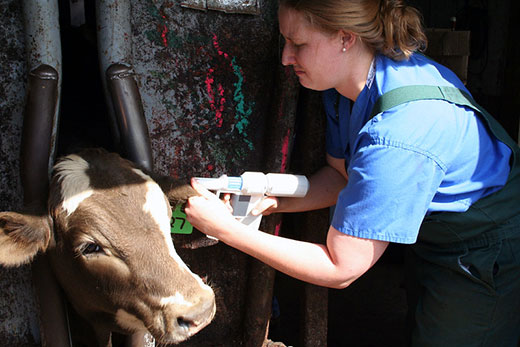
Spring is the right time to administer an implant in a 45-90 day old calf. | Download this photo.
K-State beef cattle experts share tips for treating calves
The COVID-19 pandemic may lead to some changes
May 19, 2020
MANHATTAN, Kan. – Spring branding and processing day is often a time when community members and families join together to administer vaccinations, castrate, implant calves and apply hide identification before summer pasture turnout.
But this spring’s COVID-19 pandemic may require some changes, said experts at Kansas State University’s Beef Cattle Institute. They offered up some advice during a recent Cattle Chat podcast.
“It is critical to have the right labor on hand to help on processing day,” said K-State veterinarian Bob Larson, adding that families may need to manage that differently this year because of the COVID-19 human health challenge.
“This COVID-19 spring means that we may need to organize our labor into family groups to promote social distance between folks who don’t live together,” Larson said.
He also said that it is important for cow-calf producers to involve help that know how to best move around the animals.
“A few people that handle cattle well are way more helpful than a bunch of folks who don’t know what they are doing,” Larson said.
One way that cattle producers can inform themselves on good animal handling protocols is to complete the National Cattlemen’s Association’s Beef Quality Assurance trainings, said Brad White, K-State veterinarian and BCI director.
Bob Weaber, a beef cattle specialist with K-State Research and Extension, added that the training helps producers understand biological products and protocols,
“For example, modified live vaccines need to be protected from sunlight, so you’ll want to have a cooler for storage when you are working the calves,” Weaber said. “Also syringe maintenance is important. If you are using an automated syringe, make sure the tubes and gaskets are clean and in good shape.”
He also said this is the time to implant the calves.
“We know that through implanting there is an improved efficiency of gain and performance of calves and that is really valuable going into this fall with so much uncertainty in the markets,” Weaber said.
White added that while the calves are gathered up, go ahead and castrate the bulls to make them steers.
White added a note of caution: “As always, it is important to work with your veterinarian to come up with the right plan to fit the needs of your operation.”

